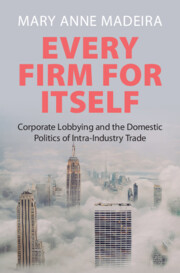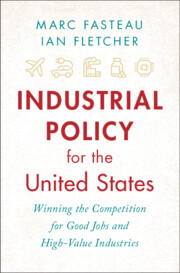Refine search
Actions for selected content:
69 results
Chapter 4 - World Literature and National Protectionism
-
- Book:
- Five Economies of World Literature
- Published online:
- 09 December 2025
- Print publication:
- 29 January 2026, pp 107-136
-
- Chapter
- Export citation
Weathering the Storm: US Trade Policy Beyond Trump
-
- Journal:
- International Organization / Volume 79 / Issue S1 / December 2025
- Published online by Cambridge University Press:
- 20 November 2025, pp. S194-S208
- Print publication:
- December 2025
-
- Article
-
- You have access
- Open access
- HTML
- Export citation
8 - Trade and Globalization
-
- Book:
- An Economic History of Europe
- Published online:
- 02 October 2025
- Print publication:
- 02 October 2025, pp 178-203
-
- Chapter
- Export citation
Picturing Protectionism: The Tariff Question in Protectionist Cartoon Propaganda in the United States, 1894‒1909
-
- Journal:
- The Journal of the Gilded Age and Progressive Era / Volume 24 / Issue 4 / October 2025
- Published online by Cambridge University Press:
- 27 October 2025, pp. 431-460
- Print publication:
- October 2025
-
- Article
-
- You have access
- Open access
- HTML
- Export citation
Voter perceptions and the politics of hidden costs in unilateral sustainable supply chain regulations
-
- Journal:
- European Journal of Political Research ,
- Published online by Cambridge University Press:
- 01 October 2025, pp. 1-16
-
- Article
-
- You have access
- Open access
- HTML
- Export citation
On the Feasibility, by Means of Customs Duties, of an Entirely (or Almost Entirely) Made-in-the-USA Automobile
-
- Journal:
- World Trade Review / Volume 24 / Issue 4 / October 2025
- Published online by Cambridge University Press:
- 29 September 2025, pp. 471-480
- Print publication:
- October 2025
-
- Article
- Export citation
Chapter 3 - Production and Prosperity
-
- Book:
- Time and Governance in Fifteenth-Century Perpignan
- Published online:
- 26 July 2025
- Print publication:
- 14 August 2025, pp 94-130
-
- Chapter
- Export citation
The politics of food in Italy: sovereignty, identity and modernity
-
- Journal:
- Modern Italy / Volume 30 / Issue 4 / November 2025
- Published online by Cambridge University Press:
- 29 July 2025, pp. 506-515
- Print publication:
- November 2025
-
- Article
-
- You have access
- Open access
- HTML
- Export citation

Every Firm for Itself
- Corporate Lobbying and the Domestic Politics of Intra-Industry Trade
-
- Published online:
- 21 July 2025
- Print publication:
- 07 August 2025
12 - Trade Protectionism and Integration in Latin America
-
-
- Book:
- Globalization in Latin America
- Published online:
- 09 June 2025
- Print publication:
- 26 June 2025, pp 255-289
-
- Chapter
-
- You have access
- Open access
- HTML
- Export citation
2 - Corporate Nationality
-
- Book:
- The Great Disruption
- Published online:
- 05 June 2025
- Print publication:
- 19 June 2025, pp 35-66
-
- Chapter
- Export citation
15 - Trade Integration
-
-
- Book:
- The Cambridge History of International Law
- Published online:
- 01 May 2025
- Print publication:
- 29 May 2025, pp 469-500
-
- Chapter
- Export citation
Capital and Labor United: Workers, Wages, and the Tariff in Late Nineteenth-Century Protectionist Agitation
-
- Journal:
- The Journal of the Gilded Age and Progressive Era / Volume 24 / Issue 2 / April 2025
- Published online by Cambridge University Press:
- 08 April 2025, pp. 157-180
- Print publication:
- April 2025
-
- Article
-
- You have access
- Open access
- HTML
- Export citation
Introduction
-
- Book:
- Industrial Policy for the United States
- Published online:
- 08 November 2024
- Print publication:
- 21 November 2024, pp 1-10
-
- Chapter
-
- You have access
- HTML
- Export citation
14 - US Industrial Policy 1750–1865
- from Part III - The Forgotten History
-
- Book:
- Industrial Policy for the United States
- Published online:
- 08 November 2024
- Print publication:
- 21 November 2024, pp 278-294
-
- Chapter
- Export citation

Industrial Policy for the United States
- Winning the Competition for Good Jobs and High-Value Industries
-
- Published online:
- 08 November 2024
- Print publication:
- 21 November 2024
1 - Introduction
-
- Book:
- Improving Procedural Justice in Anti-Dumping Investigations
- Published online:
- 09 May 2024
- Print publication:
- 16 May 2024, pp 1-19
-
- Chapter
- Export citation
16 - The Free Movement of Goods
-
- Book:
- European Union Law
- Published online:
- 19 March 2024
- Print publication:
- 28 March 2024, pp 668-703
-
- Chapter
- Export citation
3 - Inhabiting the Rule
-
- Book:
- Who Is a True Christian?
- Published online:
- 04 January 2024
- Print publication:
- 22 February 2024, pp 128-175
-
- Chapter
- Export citation
A World by Themselves: Protectionism and the Political Economy of Trade in the Ohio Valley, 1816–1828
-
- Journal:
- Enterprise & Society / Volume 26 / Issue 1 / March 2025
- Published online by Cambridge University Press:
- 10 January 2024, pp. 94-118
- Print publication:
- March 2025
-
- Article
-
- You have access
- Open access
- HTML
- Export citation
